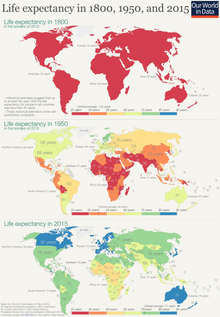预期寿命

(Our World in Data图表)
預期壽命(英語:life expectancy)[1][2]又称期望寿命[3]、生命期望、平均餘命[4],是衡量单一生命存活平均长度的统计量。預期壽命最常用的測量方法是自出生起算,称为出生时预期寿命[5](英語:Life expectancy at birth,LEB),也常按照不同的性別和年齡作統計。
現代人的預期壽命遠高於古代人,但這主要是因為嬰幼兒死亡率的巨幅下降所致,古代平均壽命低,和嬰幼兒夭折率高有關,所謂的「古代人平均壽命都不超過50歲,因為很多人在30-40歲的青壯年期間因為戰亂或疾病而離世」之類的說法,是全然錯誤的。[6][7]古代顺利发育至成年的人,因為已經规避了許多會在幼年時期導致死亡的因素,故一般至少能活到中年以后。
預期壽命是衡量國家福祉及繁榮的指標之一。
預期壽命的迷思
不論用什麼方法來測量,現代人的預期壽命確實比中世紀或更以前的人高出許多[6];不過,出生時的預期壽命常常錯誤地和一個成年人預期可存活的壽命相混淆,這個混淆會導致所謂的「古代人平均壽命都不超過50歲,因為很多人在30-40歲的青壯年期間因為戰亂或疾病而離世」這種錯誤的印象;而在事實上,成年人已經避免了許多會在幼年時期導致死亡的因素,因此事實上成年人的預期壽命,會遠遠高於出生時的預期壽命[7]。過去醫藥水平不高,因而嬰幼兒夭折率高,進而將平均壽命拉低,才是古代平均壽命低的最大原因。不同年齡的人的預期壽命,尤其是兒童期之後的人的預期壽命,常常會和出生時的預期壽命,有很大的差異,尤其在工業革命前更是如此,[7]像例如說在十三世紀時,英國貴族的平均壽命大約是30歲,但當時,對於活到21歲的成年男性而言,他們的預期壽命大約是64歲。因此拿古代(包含新生兒壽命和成年人壽命在內)的平均壽命來估計當時成年人普遍能夠活到的年紀,是沒有意義的。
健康预期寿命
2001年,世界卫生组织公布了健康预期寿命(healthy life expectancy 或 active life expectancy)統計數據,健康预期寿命是指一个人在 「完全健康」的情况下可预期的平均寿命,不包括由于疾病或受伤而导致的健康状况不佳的時間[8][9] 。
历史
19世纪初,全球各地平均寿命不超过40岁,一半人口在成年前夭折,而嬰幼兒夭折率高,也是工業時代以前平均壽命低的最大原因。1800年之前,只有欧洲少数精英阶层的人均寿命超过40岁。1820年左右,西欧平均寿命是36岁,日本是34岁。中国贵族的人均寿命由1800年代初的37岁降至1830年后的32岁[10]。欧洲国家进入工业化早期,人均寿命曾有所下降[10],其后有大幅提高。西欧发达国家自19世纪早期开始快速提高,至1950年时达到65岁。与西欧类似,北欧、北美、澳新的平均寿命在1950年代时接近70岁。南欧、东欧则在20世纪初由40岁提高到50岁,于1970年代时追赶上西欧。二战结束后,大部分发展中国家的人均寿命随着死亡率下降而增加。1950年时,发展中国家平均寿命为40岁,1965年,提高至50岁。其中在1970年代中期,非洲平均寿命47岁,亚洲为57岁,拉丁美洲达为62岁。1990年代,发达国家平均寿命达到73岁,发展中国家平均寿命57岁,但发展中国家平均寿命状况不一,并不均衡[11]。
影响因素
经济、文化、医疗是多种影响因素。婴儿死亡率是影响平均寿命的直接因素之一[11],嬰幼兒死亡率的巨幅下降,也是近現代平均壽命增長的最大原因。
注释
- ^ 存档副本. [2021-09-28]. (原始内容存档于2022-07-21).
- ^ 存档副本. [2021-09-28]. (原始内容存档于2022-07-21).
- ^ 存档副本. [2021-09-28]. (原始内容存档于2022-07-18).
- ^ 存档副本. [2021-09-28]. (原始内容存档于2022-07-18).
- ^ 存档副本. [2021-09-28]. (原始内容存档于2022-05-22).
- ^ 6.0 6.1 John D. Hawks, John, Human lifespans have not been constant for the last 2000 years, 2009 [2019-06-15], (原始内容存档于2019-06-28).
- ^ 7.0 7.1 7.2 Christopher Wanjek, Christopher, Bad Medicine: Misconceptions and Misuses Revealed, from Distance Healing to Vitamin O, Wiley: 70–71, 2002, ISBN 047143499X.
- ^ Healthy life expectancy (HALE) at 60 (years). World Health Organization. [2021-04-14]. (原始内容存档于2021-05-23) (英语).
- ^ Health Status Statistics: Mortality. World Health Organization. [2021-04-14]. (原始内容存档于2012-07-04) (英语).
- ^ 10.0 10.1 "长寿时代":19世纪以来各国人均寿命的增长. 网易. 2016-11-07 [2018-01-03]. (原始内容存档于2018-01-03) (简体中文).
- ^ 11.0 11.1 梁铭会. 《人口平均寿命的变化趋势》. 中国慢性病预防与控制 (天津市河东区: 中华预防医学会 天津市卫生防病中心). 1993, (1993年第3期). ISSN 1004-6194. (原始内容存档于2021-04-23) (简体中文).
相关条目
| |||||||||||||||||||||||||||
| |||||||||||||||||||||||||||||||||||||||||||||||
Text is available under the CC BY-SA 4.0 license; additional terms may apply.
Images, videos and audio are available under their respective licenses.
